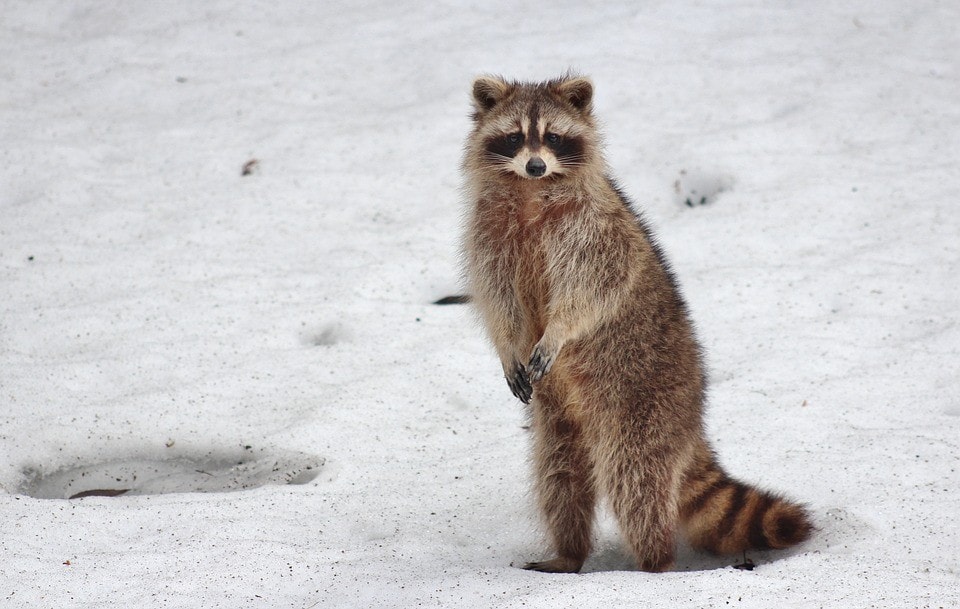


By fall the young can hunt for themselves and soon disperse. Ringtails are solitary, only pairing up for a few days of mating in April. They den in niches in rock walls, boulder piles, or hollow trees. The ringtails have semi-retractable claws and can rotate their hind feet 180 degrees, allowing them to descend cliffs face first. They are excellent climbers and leapers, using their long tails for balance as they negotiate steep canyon walls or trees with equal ease. Ringtails are strictly nocturnal animals, using their large eyes and keen sense of smell to locate prey. In the warm desert climate, a raccoon may sleep away the day out in the open, draped over a tree branch. They can eat almost anything their dexterous paws can easily open garbage cans, so they can readily take advantage of discarded food. They prefer brushy, thickly vegetated habitats, but adapt very well to the many artificial ponds, lakes, and wetlands found in the suburbs and housing developments. Raccoons are nocturnal and usually solitary, unless they congregate at man-made food sources such as picnic areas or campgrounds. They also turn over large rocks with their front paws to search for invertebrates, lizards, and snakes. Coatis dig in the soil and leaf litter using their long claws or their noses to turn up grubs, worms, or other invertebrates. They are excellent mousers, pouncing and killing with a bite to the back of the rodent’s neck. Ringtails inspect likely niches and hiding spots in their rocky habitats, hunting for rodents, birds, centipedes, and anything else edible. Behavior: Raccoons use their front paws to feel for food items in murky water or leaf litter. The coati eats a lot of grubs, beetles, and other invertebrates, and also fruits and nuts, rodents, eggs, snakes, lizards, and carrion. The ringtail favors a diet of rodents, fruit, birds, snakes, lizards, and insects. The raccoon feeds on small mammals, carrion, fruit and nuts, insects, eggs, fish and aquatic insects. Coatis inhabit mountain canyons with oak and sycamore in the summer, sometimes moving to lower-elevation riparian canyons or passing through desertįeeding Diet: All three species are omnivores.

The ringtail lives most often in riparian canyons, especially in areas with rocky outcrops, caves, and mine shafts, and usually not in heavily wooded areas. Raccoons prefer riparian habitats, and brushy and wooded areas. Its very long tail is not as distinctly ringed as are those of the raccoon and ringtail. Coati: The coati is a curious-looking beast, longer than a racoon (though not as husky in the body), with a long nose and a facial mask. Unlike raccoons and coatis, ringtails don’t walk on the soles of their feet, one reason they are sometimes placed in their own family (Bassariscidae). It has large black eyes ringed with white, big ears, and a narrow, pointy muzzle. Ringtail: A grayish-brown squirrel-sized animal (about 1 to 2 pounds) with a fluffy black and white ringed tail that is usually longer than its body. The hind foot is plantigrade (that is, the sole is walked on, as with humans). Spanish names: mapache, batepi, lavador (raccoon), cacomixtle (ringtail),ĭistinguishing Features Raccoon: A heavy-bodied animal of about 10 to 30 pounds (4.5-13.5 kg) with a black face mask edged in white and a bushy, ringed tail. Like the raccoon and the ringtail, coatis forage both on the ground and in trees, and are omnivores. One can sometimes be seen at night as it prowls around its rocky canyon home, peering into niches and cracks where a mouse or an insect might be hiding.Įven though the coati is diurnal and lives in social bands of up to 30 or more animals, most people never see them, unless they make frequent visits to the oak-sycamore canyons and riparian areas coatis favor. Large black eyes, big pink ears set on a tiny face, and a long black-and-white ringed tail that looks like a feather boa make this appealing little animal look almost cuddly, but it is really a very efficient predator. The ringtail is Arizona’s state mammal, though few people have ever seen one in the wild. You can easily follow raccoons’ distinctive tracks along trails leading directly to suburban desert swimming pools. Many are surprised to learn that the raccoon does quite well in the Sonoran Desert, as long as there is water somewhere nearby. The raccoon is the most familiar of these, but mostly because people have seen it in other parts of the country. Among the most unusual, most handsomely marked, and least known of our desert animals are the procyonids - the raccoon, ringtail, and coatimundi.


 0 kommentar(er)
0 kommentar(er)
